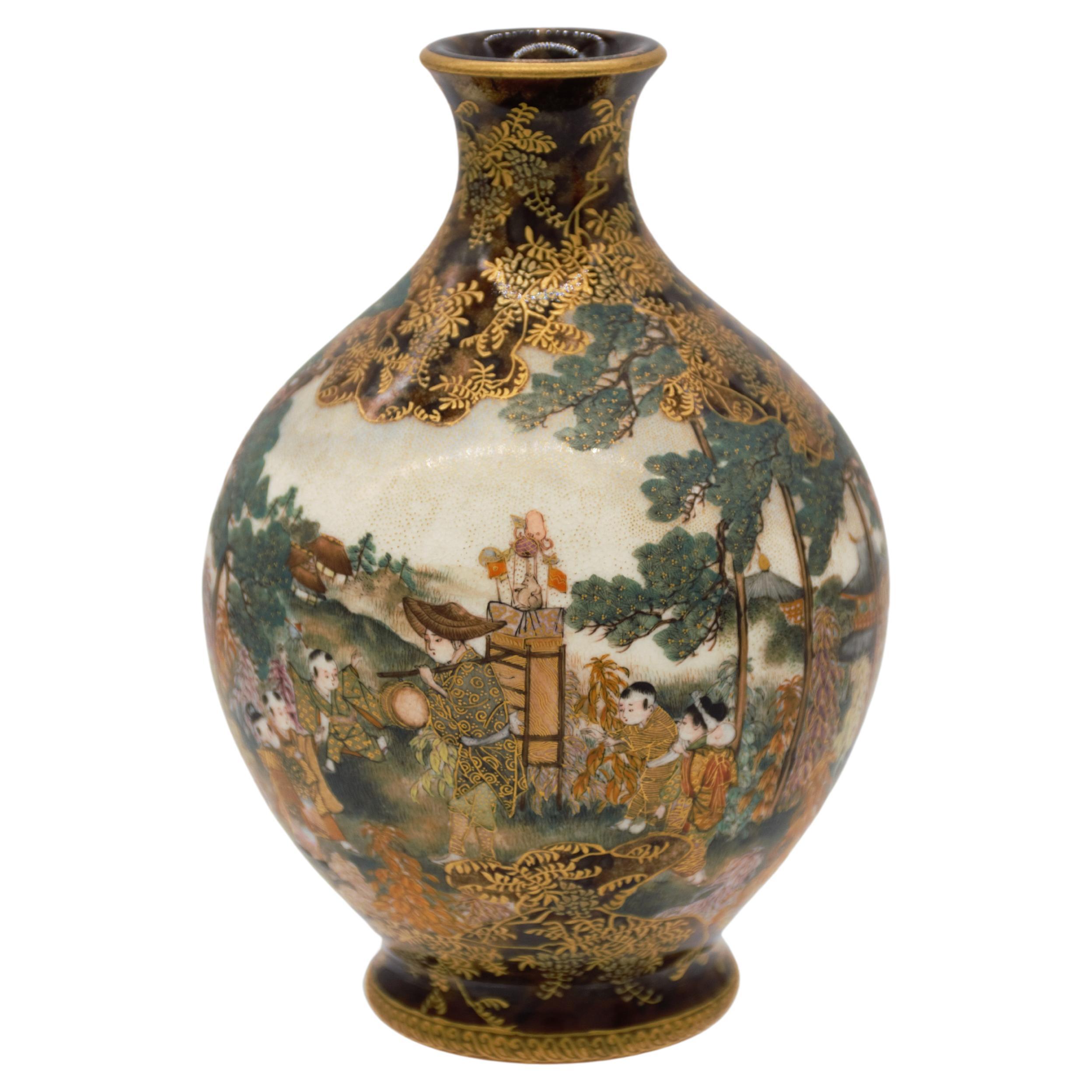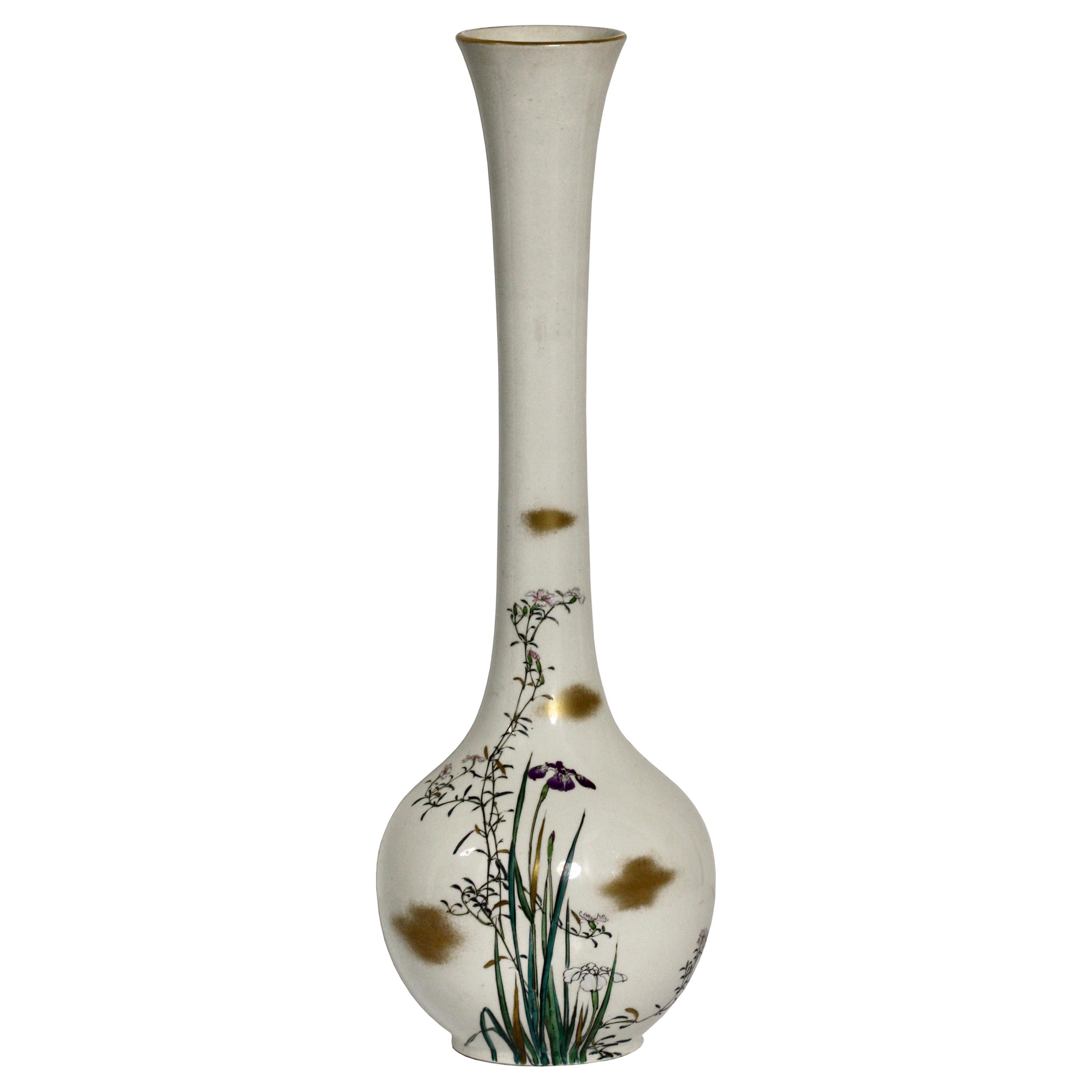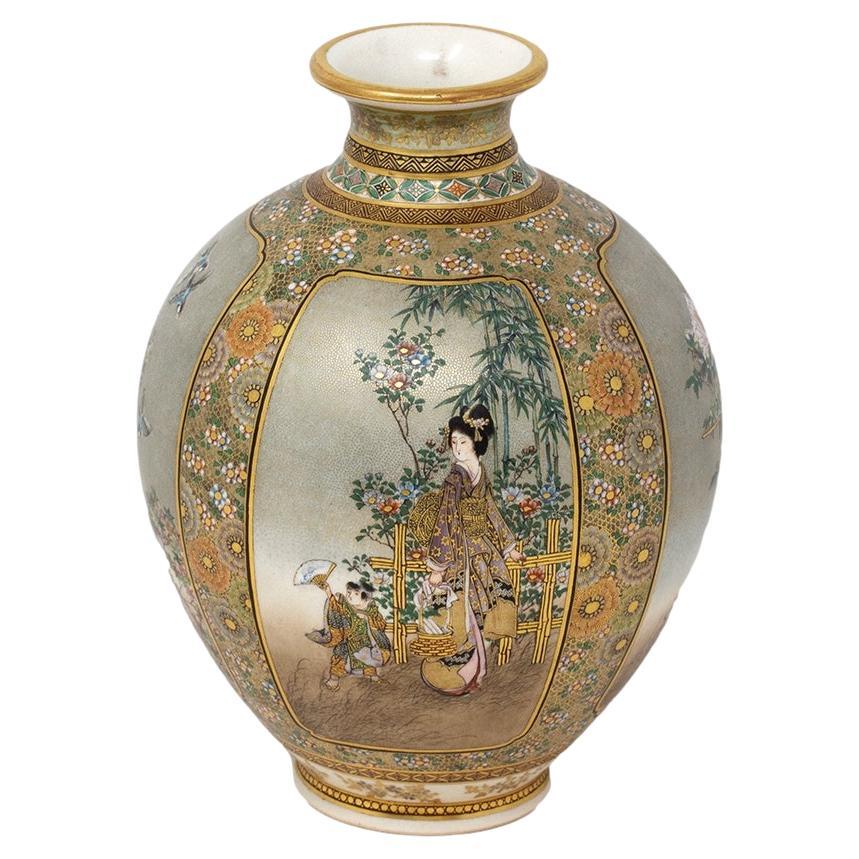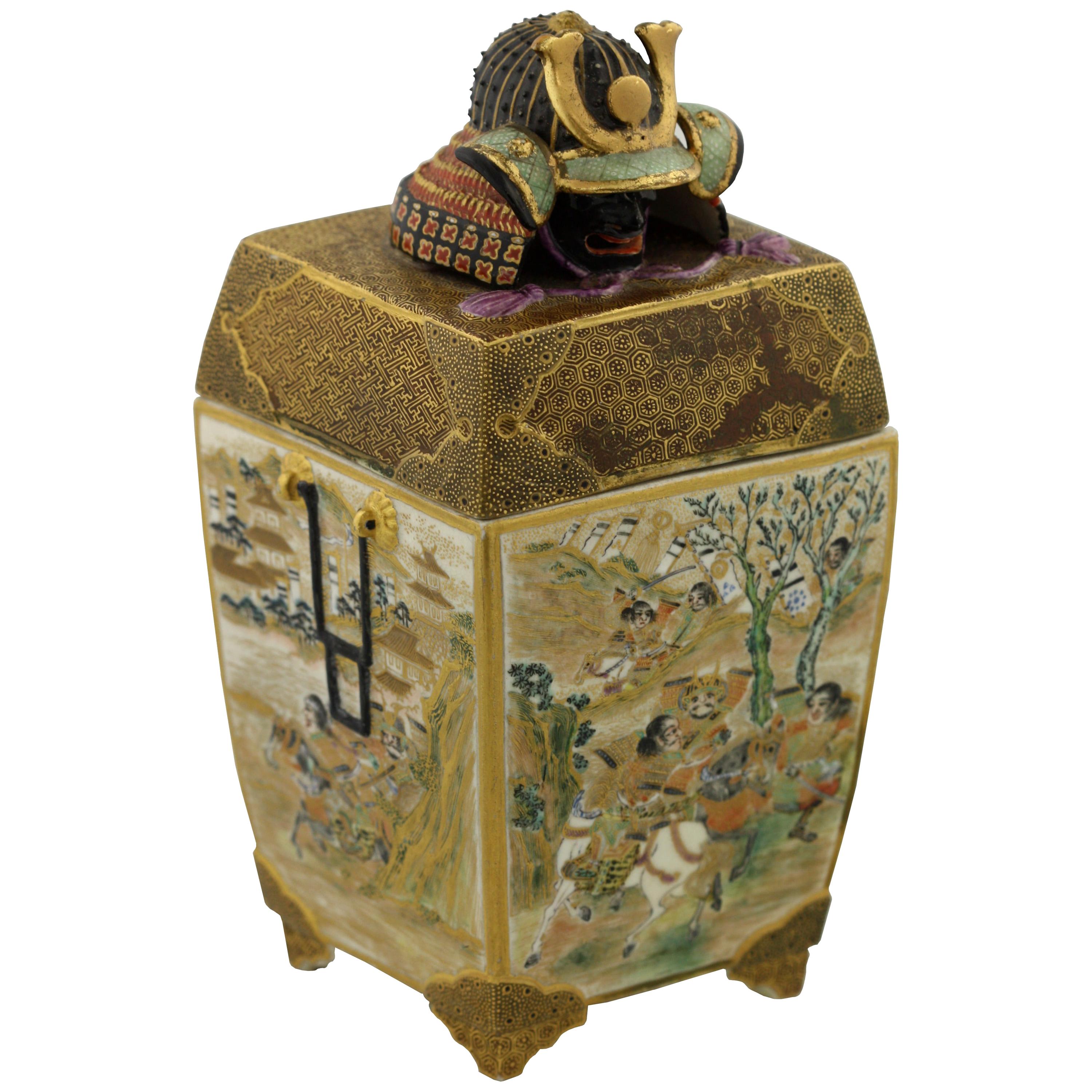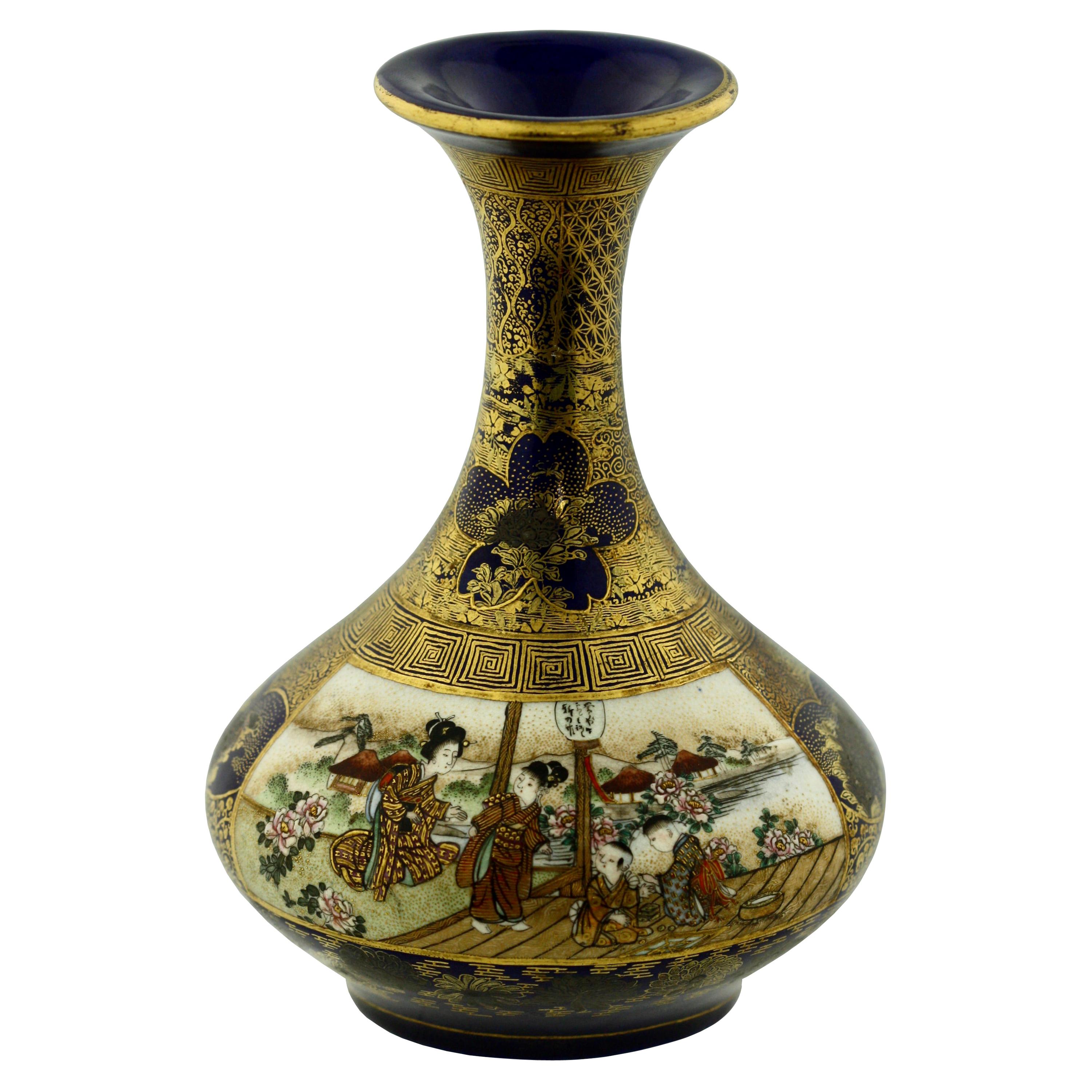Items Similar to Japanese Satsuma Earthenware Vase by Kinkozan, Meiji Period
Want more images or videos?
Request additional images or videos from the seller
1 of 8
Japanese Satsuma Earthenware Vase by Kinkozan, Meiji Period
About the Item
A Japanese Satsuma Earthenware Vase by Kinkozan, Meiji period (1868-1912)
The body inset with two panels, one depicting figures seated around a table, the other painted with a joyful scene in a shrine, all reserved on a blue ground decorated with a gilt flower pattern, signed Nihon Kyoto Kinkozan zo, Mitsutoshi kore ga, and sealed Kinkozan zo
Height 30 cm., 12 in.
Diameter 4.5 in., 11.43 cm.
- Creator:Kinkozan (Artist)
- Dimensions:Height: 12 in (30.48 cm)Diameter: 4.5 in (11.43 cm)
- Materials and Techniques:
- Period:
- Date of Manufacture:20th Century
- Condition:Wear consistent with age and use.
- Seller Location:West Palm Beach, FL
- Reference Number:1stDibs: LU3860133380062
About the Seller
5.0
Vetted Seller
These experienced sellers undergo a comprehensive evaluation by our team of in-house experts.
Established in 1989
1stDibs seller since 2018
92 sales on 1stDibs
Typical response time: 8 hours
- ShippingRetrieving quote...Ships From: West Palm Beach, FL
- Return PolicyA return for this item may be initiated within 3 days of delivery.
More From This SellerView All
- Kinkozan, Japanese Satsuma Vase, Meiji PeriodBy KinkozanLocated in West Palm Beach, FLKinkozan, Japanese Satsuma vase, Meiji Period (1868-1912) Of baluster form with an elongated neck decorated in polychrome enamels and gilt on a clear crackle glaze in an Art-Nouvea...Category
20th Century Ceramics
MaterialsCeramic
- A Pair Satsuma earthenware vases by Kinkozan, Meiji periodBy KinkozanLocated in West Palm Beach, FLA Pair Satsuma earthenware vases by Kinkozan, Meiji period of square section, decorated with birds and flowers alternating with figures, all reserved on a midnight-blue ground with floral designs, each signed Kinkozan zo...Category
20th Century Vases
MaterialsCeramic
- Satsuma Earthenware Vase and Cover, Japanese, Meiji PeriodBy SatsumaLocated in West Palm Beach, FLA Satsuma Earthenware vase and cover, Japanese, Meiji period, (1868-1912) decorated in polychrome enamels and gilt over a clear, crackled glaze, delicately painted with samurai on ...Category
Antique 1890s Antiquities
MaterialsCeramic
- Japanese Kinkozan Gilt and Enameled Blue-Ground Vase, Meiji PeriodBy KinkozanLocated in West Palm Beach, FLJapanese Kinkozan Gilt and Enameled Blue-Ground Vase, Meiji Period (circa 1900), GILT MARK WITHIN A SQUARE, of compressed baluster form with short everted neck, decorated with rectan...Category
Antique Early 1900s Antiquities
MaterialsEnamel
- Satsuma Earthenware Vase, by Kinkozan, Japanese, Meiji PeriodBy SatsumaLocated in West Palm Beach, FLA Satsuma Earthenware Vase, by Kinkozan, Japanese, Meiji period (1868-1912) decorated in polychrome enamels and gilt over a clear, crackled glaze, delicately painted with ladies and men, the reverse with a flowering garden with sprays of flowers, the neck with geometric and floral designs, a band of kifu heads in silver and gilt above the foot, on a midnight-blue ground, signed Kinkozan zo...Category
Antique 1860s Vases
MaterialsEarthenware
- An Earthenware Dish By Kinkozan, Meiji period, late 19th centuryBy KinkozanLocated in West Palm Beach, FLAn earthenware dish By Kinkozan, Meiji period, late 19th century Painted in polychrome enamels and gilt over a clear crackled glaze with beauties and children enjoying a summer outing in a mountainous water landscape, the scene surrounded by a frame of blossoming flower heads, signed in gilt Kinkozan zo...Category
Antique 19th Century Antiquities
MaterialsCeramic
You May Also Like
- Satsuma earthenware vase by kinkozan, Meiji periodBy KinkozanLocated in Tel Aviv - Jaffa, ILthe body of this small marvelous vase is painted with a scene of a puppet show vendor with his wood backpack, on top of the backpack there are toys and dolls, he is surrounded with a group of 6 children, and on the background you can see a village. on the other side of the vase there is an amazing painting of flowers and on the sides there are two amazing strong pine trees, the amorphous background is decorated in a "Tortoiseshell" color and design that gives it a real character and which is quite rare to see on satsuma pottery. all the vase is over richly overpainted over the glaze with gold, which gives it its depth and realism. signed Kyoto Kinkozan zo, and sealed Kinkozan zo Kyoto’s Satsuma: The painting technique used in Kyoto’s Satsuma-style ware is said to be the invention of the sixth generation Kinkōzan Sōbei (1824–1884). The Kinkōzan were a famous family of Kyoto Awataguchi potters who made ceramics that were used at Shōren'in, a temple closely tied to the imperial family, and by the shoguns of the Edo government. In fact the shogun is said to have granted them the name Kinkōzan. With the upheavals at the end of the Edo period, however, and the reforms of the subsequent Meiji government, the potters lost their traditional patrons and had to develop new markets. Just at that time, the visit of a certain Westerner is said to have decided them to embark on overseas trade. By 1870, they had perfected Kyō Satsuma...Category
Antique 1890s Japanese Meiji Ceramics
MaterialsGold
- Japanese Meiji Period Satsuma Vase by KinkozanBy KinkozanLocated in Newark, EnglandThe vase is potted in globular form with a tightly pinched neck and rolled top rim beautifully decorated with four highly detailed individual panelled scenes. The first a Geisha bari...Category
Antique Late 19th Century Japanese Meiji Ceramics
MaterialsCeramic, Earthenware, Pottery
- Japanese Meiji Period Satsuma Bowl KinkozanBy KinkozanLocated in Newark, EnglandFrom our Japanese collection, we are delighted to offer this Japanese Meiji period Satsuma Bowl by Kinkozan. The earthenware bowl with pinched rim extensively decorated on both the exterior and interior. The bowl with a cobalt blue base glaze decorated to the borders with gilt shippo-tsunagi (linked-cash) with scattered medallion roundells. Around the exterior two elongated scenes are featured, one with boys playing games in a courtyard with the other featuring seated scholars in full dress both with raised enamel decoration. The interior features a central scene with Samurai warriors in training fully armoured with swords in a courtyard with landscapes scenes to the background. The central scene bordered by further stylised shippo-tsunagi type decoration with a greek key rim border. The bowl signed to the base Kinkozan dating to the Meiji Period (1868-1912) circa 1900. Shippo-Tsunagi (linked-cash) or seven treasures, is a traditional Japanese geometric pattern that combines four ellipses in a circle. These ellipses repeat outward to then create more circles, symbolising eternal peace and happiness. Kinkozan the Kinkozan family have been associated with pottery dating back to 1645. They went on to become the largest producer of Satsuma ware by one individual company, from the end of the 19th century until 1927 after which the factory closed. By the 1850s Kobayashi Sobei (1824-84), Kinkozan Sobei...Category
Antique Early 1900s Japanese Meiji Ceramics
MaterialsCeramic, Earthenware, Pottery, Faux Leather
- Japanese Meiji Period Satsuma Plate by KinkozanBy KinkozanLocated in Newark, EnglandPainted with Two Snipe Amongst Iris From our Japanese collection, we are delighted to offer this Japanese Meiji Period Satsuma Plate by Kinkozan. The Satsuma Plate is extensively de...Category
Antique Late 19th Century Japanese Meiji Ceramics
MaterialsCeramic, Earthenware, Pottery
- Large Japanese Satsuma Vase by KinkozanBy KinkozanLocated in Christchurch, GBAs part of our Japanese works of art collection we are delighted to offer this finely decorated Meiji Period (1868-1912), Satsuma vase stemming from the highly regarded Kinkozan stud...Category
Antique Late 19th Century Japanese Meiji Ceramics
MaterialsCeramic
- Fine Japanese Ceramic Satsuma Vase by KinkozanBy KinkozanLocated in Atlanta, GAA miniature Japanese ceramic vase from the end of Meiji period circa 1880s- 1910s by Kinkozan (1645-1927). One of the largest studio manufacturers of the export ceramics at the time ...Category
Early 20th Century Japanese Meiji Ceramics
MaterialsCeramic
Recently Viewed
View AllMore Ways To Browse
Vintage Period
Gilt Flower
Asian Seal
Earthenware Flowers
Kyoto Vintage
Flower Seal
Japanese Satsuma
Signed Asian Vases
Meiji Panel
Japanese Earthenware
Earthenware Japan
Asian Shrine
Asian Art Signed With Seals
Used Furniture Ga
Asian Blue Vases With Flowers
Used Furniture In Ga
Vintage Ceramic Asian Vase
Japanese Earthenware Vase
